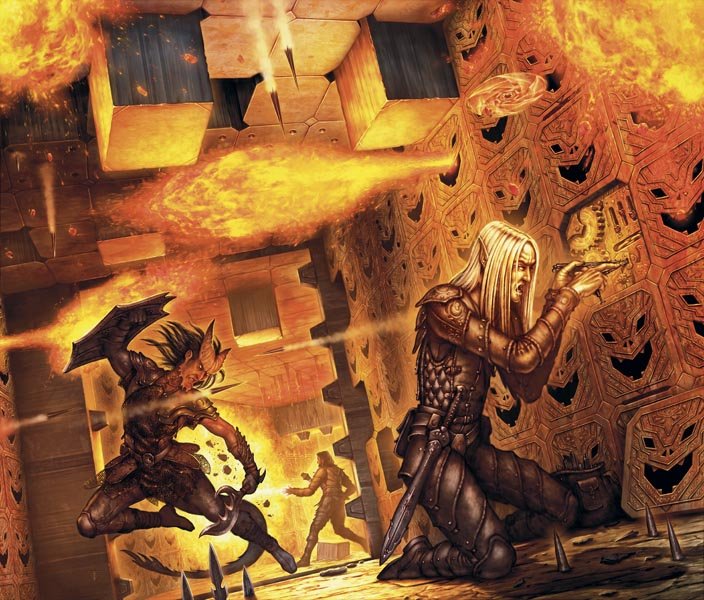Sometimes you need to add some extra spice to your campaign. Here are some extra rules you can use to flavor your campaign a little.
The right extra rules for a campaign can make all the difference. They set the tone for ground zero of your next adventure. Maybe you play with higher level stuff, or with the looming knowledge that the gods will devour the world at some point during the campaign. A good suite of “campaign rules” can add some extra flavor and interest into just about any campaign. Here’s a look at a few common ones.
Start at Higher Levels

This one’s real easy. A lot of people do this already, but maybe you haven’t tried it yet. If not, you should. Starting at a higher level can just give you a big momentum boost into any campaign. It’s maybe not the best for total newbies, but after a while, start at level 3 or level 5, or even level 9 or 10 and then see where you go from there.
I personally like playing around with what level a campaign starts off at, because it lets you reframe who your heroes are. You might not be just some novice swordfighter—instead you could be a seasoned warrior. Or if you’re starting at level 9 or whatever, you might already have a position of power in the world. And that can be real fun to play with. Especially considering the next campaign rule…
Run a Faction

As long as you’re playing with a higher level start, you might as well also think about playing in a game where players have the run of (or at least some authority in) an organization of some kind. Maybe it’s a thieves’ guild, or a warrior’s cadre or whatever. D&D is full of factions with vague goals like the Zhentarim or the Harpers. All you have to do is add your own.
Or make a kingdom all your own. There are plenty of existing houserules out there that talk about how to run a faction/kingdom. And non-house rules as well, like Reign, for instance. Point is, you’d be surprised at how much work people have already put into figuring this out. But all you really need to know is that whatever you come up with, it just has to feel like everyone gets to make interesting choices.
Backup Characters in the World

Or you can goa nother route, and promise a deadlier game. Say from the outset, “you will need a backup character.” Because a) that sets the tone, and b) if that never happens, then the player that doesn’t have to switch characters will feel amazing for surviving what is surely to be a tough game. And this is really just a magic trick, but you’d be surprised at how effective it can be.
Especially if you do something like introduce the backup characters as people in the world. Because then your PCs will know who they are and what they’re up to. It can be a fun way to tease that things are getting a little deadlier—you can give the backup characters a little time to shine every now and then. And all it really is, is making the promise that if someone’s character dies, you know where the replacement is coming from. It’s just framed as sort of a “challenge”.
A Big Countdown

Sometimes you gotta build a campaign with the end in mind. And one way to do that is to have a literal ticking clock. This is something you might see in games like XCOM 2 where the Aliens win if they finish work on the Avatar project—it’s a countdown that you’re racing against to try to win. And you can take actions to slow it down, but eventually, you know that clock is going to run out.
This can be great for a short campaign, or even a longer one where the PCs have ways to push against the clock. Maybe it’s a countdown until the world ends (devoured by the gods), or maybe it’s just a countdown that ends with a new ice age covering the world, and now if your characters can survive, the campaign changes.
Either way, having something visible that lets the players know how much longer they have can be an interesting challenge. You could run the clock down at whatever interval you like. Every week. Every month. Maybe at dawn or whenever the villains accomplish a specific goal it clicks down. Either way, let the clock start ticking.
Hex Appeal

Finally, one of my favorite campaign rules, a big ol’ hex map of uncharted territory. What I love about this is you can play with this kind of thing in any campaign where players travel. As long as you don’t set things entirely in one city, you can use a rule like this.
It boils down to, have a map but don’t fill it out completely. Leave a number of hexes (or squares if you’re using an inferior map) blank. And only fill them out when someone goes there in the game. Even as a DM I would suggest waiting to figure out what’s in the hex—you can roll it up randomly and then jump and justify (or do it beforehand if you don’t like to improvise at the table). Or if you have an idea of what might be in there, wait until the players move in. Let yourself be as surprised as they are.
It keeps movement and exploration fresh and exciting throughout the length of your campaign.
Happy adventuring!
Don’t Miss:
Read more at this site
